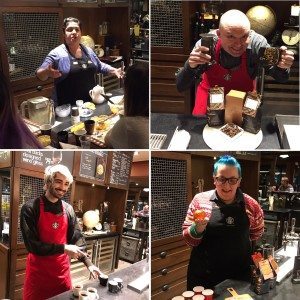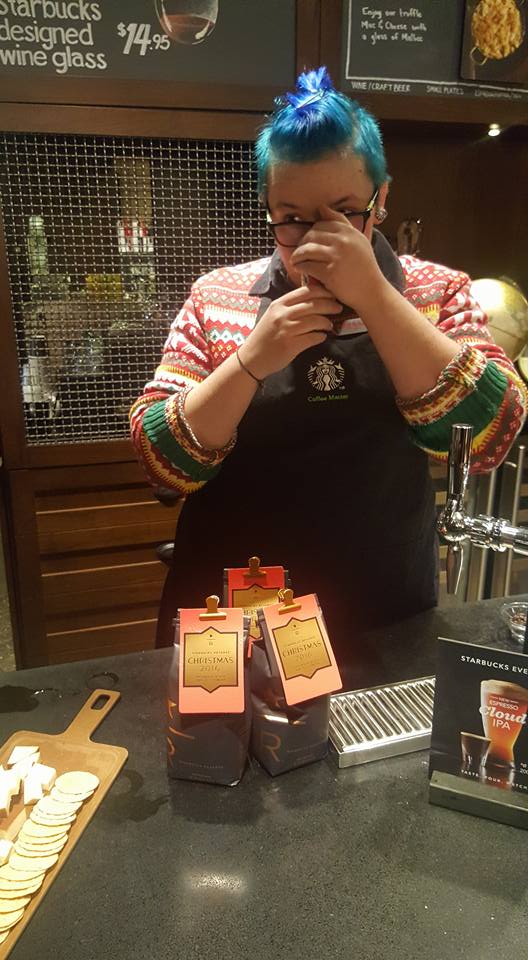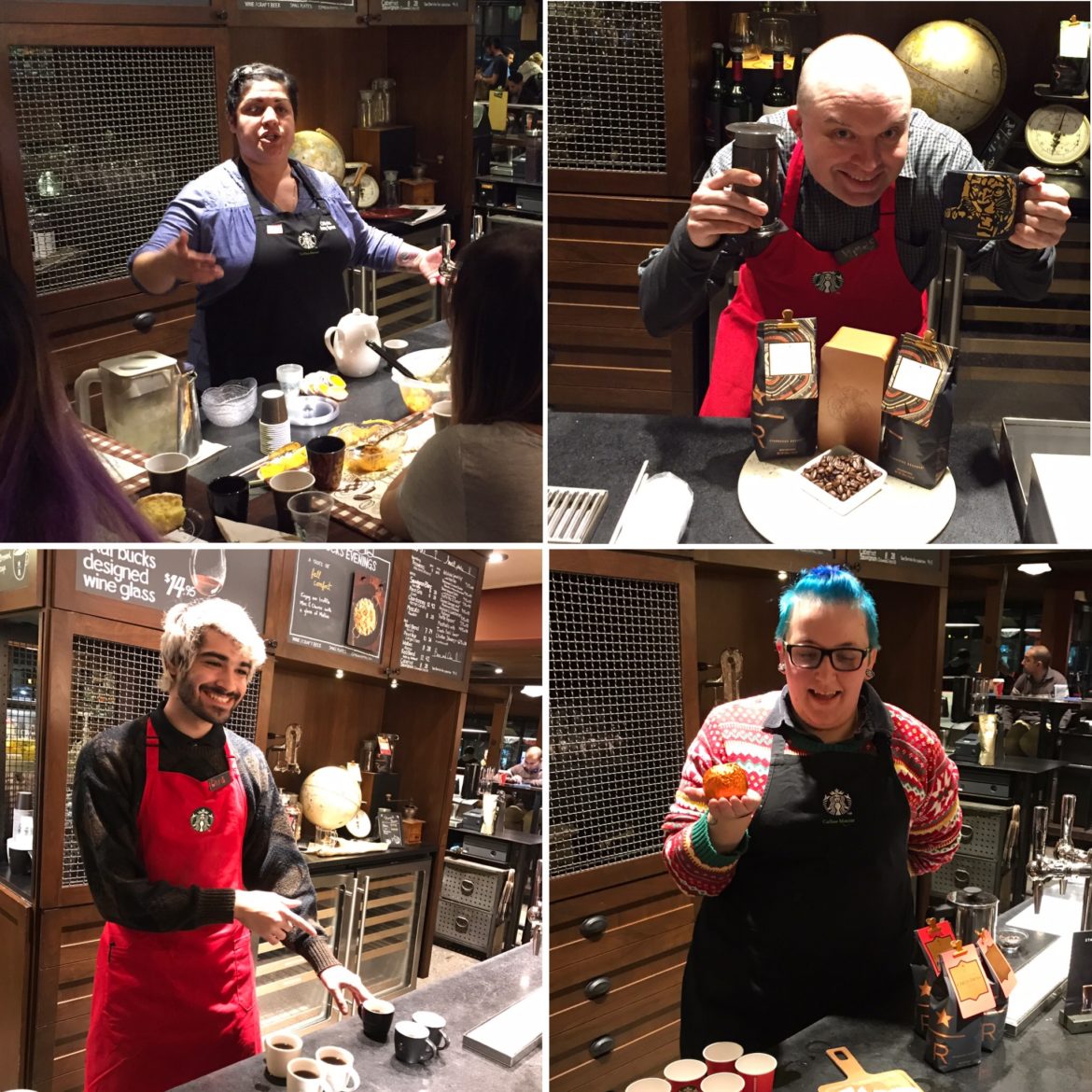 Sometimes I get emails from partners asking for tips in how to leading a great coffee tasting. It’s a great question! So let me give you some pointers on what to think about when you’re about to lead a coffee event.
Sometimes I get emails from partners asking for tips in how to leading a great coffee tasting. It’s a great question! So let me give you some pointers on what to think about when you’re about to lead a coffee event.
(Starbucks calls their employees ‘partners’.)
TRY THE FOOD WITH COFFEE FIRST:
If you are pairing food with coffee, be sure to try the food with the coffee first. Don’t just wing it.
I remember one time going to a coffee seminar where a partner (Starbucks calls their employees, ‘partners’) paired a curried chocolate bar with Jamaica Blue Mountain. He hadn’t tried the pairing first and winged it. A heavily Indian curry spice chocolate and Jamaica Blue Mountain didn’t work together. Always give your pairing a try first before trying it out in front of a crowd. Be cautious when you are pairing coffee and food: Is the food really bringing out an aspect of the coffee, or is it covering some of the coffee flavor? You don’t want your food to mask the coffee.
COMPARE AND CONTRAST:
Compare and contrast coffees: One fabulous way to learn about coffee is to compare, compare, compare. Sometimes you’ll hear partners only emphasize food with coffee. In order to really grow in coffee education, you should do both. You should look at a couple of different coffees side by side in order to compare and contrast. Both are important: customers at home try their coffee with food. So that aspect of learning about coffee is important too. Several years ago I wrote about a coffee tasting that I went to that was a comparison of 3 Panama coffees. It was fabulous. It’s a great example of comparing different coffees all from the same growing region.
Years ago, I met the guy who wrote the current Starbucks Coffee Master book. I remember him telling me that every coffee tasting should have at least two coffees. Over the years I’ve figured out that you need both experiences:
- You need to compare and contrast multiple coffees of different process methods, different farms, different varietals, and different regions and more.
- And your customer is likely going to be enjoying their coffee at home with food: So having a good understanding of how food and coffee pair together is also important. If done right, you can use food to highlight different aspects of the coffee. For example, if you are tasting Starbucks Christmas Reserve 2016 coffee, you can highlight the cinnamon-spice notes of the coffee with Trader Joe’s Cinnamon Stars Cookies.
- Don’t only focus on coffee and food together.

HAVE THE BAG OF BEANS READY TO SMELL:
Coffee is made from coffee beans. Always have a bag of coffee beans ready to smell. The beginning of the story (of making the coffee in a store or at home) is always the same: You rip open the bag of coffee and smell the beans.
Make sure your audience has the chance to smell the whole beans. You could place a small amount on a tray or in a 2 ounce cup and pass it around.
What do these beans smell like?
WALK THROUGH ALL FOUR STEPS OF A COFFEE TASTING:
- Smell – Place your hand around the cup and have a big smell of the aroma. DO NOT refer to this step as a “cupping.” I hear this all the time. It is incorrect and it is not a “cupping”. Those who really understand coffee in the industry and who work in coffee quality will think that you don’t know what you’re talking about if you refer to this step as “cupping.” I don’t know why this mistake is so common, but please don’t do it. I don’t have a perfect “cupping” article on this blog, but you can kind of see what a “cupping” actually is by looking at this article I wrote 6 years ago. A “cupping” is a specialized method of tasting coffee used often by those employed in coffee sourcing, coffee quality, or coffee blend development.
- Slurp – Give the coffee a big slurp. Allow both coffee and some air to enter your mouth.
- Locate – Where do you taste the coffee? Is it on the front of your mouth? All over? Down the center.
- Describe – Describe what you taste. If you are pairing coffee with food, try the food and then drink the coffee one more time. Try to detect if there’s any difference in how the coffee tastes after eating the food.
Don’t rush through these four steps. These four steps are the main event.
BE KNOWLEDGEABLE ABOUT YOUR COFFEE:
Can you talk about whether it is a pre-roast blend or a post-roast blend? Are you tasting single origin coffees? How did the farmers practices affect the flavor of the coffee.
A good example of a farmer intentionally changing the flavor of the coffee with processing methods is what happens with certain Costa Rican coffees. Take a look at honey-processed coffees for more information.
Are you familiar with how or why a coffee is a certain roast profile? Christmas Reserve 2016 is a blonde roast profile.
You’ve got a story to tell about your coffee. This is your chance to show you know your coffee backwards and forwards. Did you know that Caffe Verona was blended to pair with whiskey? Always do a Google search on your chosen coffee. You never know what you might find. Don’t assume you know it all because you read a coffee fact sheet. Did you know that Breakfast Blend was introduced in 1998 to attract customers who wanted a lighter roast profile, and it was one of four coffees all launched at the same time? The four coffees were called, “Milder Dimensions” coffees.
If you can, try to capture some of the green coffee story: Did you know that once in a while some coffees don’t come to Starbucks in burlap sacks? This Cup of Excellence coffee came to Starbucks in plastic bags. And by the same token, if you have the chance to see or share about the green coffee and burlap sacks, add that information in to your coffee event. It’s all part of your coffee’s story. Did you know that Ka’u coffee sacks almost never name the actual farm the coffee came from on the burlap sacks themselves?
SPEAK UP AND MAKE IT A GROUP EVENT:
Speak up! And make it fun. Start out with everyone there introducing themselves and telling something fun like why they’re at a Starbucks or any coffee memory. But please speak up! Project.
INVITE YOUR CUSTOMERS TO BUY COFFEE:
When you are all done with the coffee seminar, be sure to remind you customers that they can take home a bag of wonderful coffee with them! Invite them to buy their at-home coffee at your store. And thank each and every customer for their purchase. “Thank you for buying your at-home coffee at East Olive Way Starbucks!”
REACH OUT TO OTHER STORES AND PEOPLE THAT HAVE HAD SUCCESSFUL COFFEE EVENTS:
Talk to other partners. Talk to customers. Ask them what they liked and didn’t like. Coffee is always a conversation. Get connected on social media. Follow Instagram profiles of stores, partners, or anyone who has a passion for Starbucks coffee.
A former Roastery partner used to say to me, “If we’re just talking to each other, we’re doing it wrong.” This is true. You are the brand ambassador teaching and spreading coffee passion. And if you look and listen, you can learn a lot from former partners, other roasters, other partners, passionate customers, and more. If you live near the Roastery, make friends with the roasters. These are the people who actually roast your coffee. The coffee roasters are a wealth of information.
If you are in Seattle, get yourself to an East Olive Way coffee tasting!
MOST IMPORTANT: HAVE FUN!!!!
Related posts
1 Comment
Leave a Reply Cancel reply
You must be logged in to post a comment.
Sponsors
Recent Comments
- DEVIN on Compostable Straws Land in Seattle Starbucks Stores
- coffeebeanz on Why do you go to Starbucks less often? (If that’s true for you)
- Willi on You can now buy a Siren statue: $6,000
- Willi on A major revamp of your drink recipe: Testing syrup extracts and cane sugar
- Skip on Why do you go to Starbucks less often? (If that’s true for you)







Thanks for this! Super helpful. I’m doing my first seminar at my store tomorrow 😀